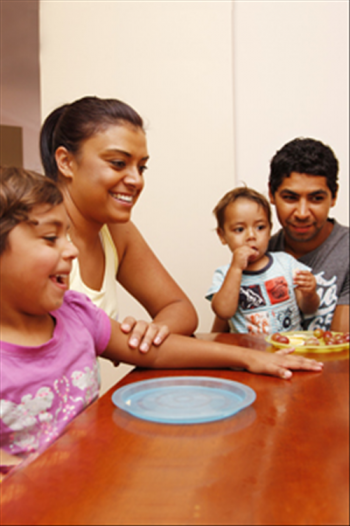Setting the table
Duration/age
Duration:
Suitable for children:
Location:

Talking about what you will eat for dinner and setting the table together helps children experiment with ways they can measure and compare their world. As you describe the food and how it will be served encourage your child to find differently shaped or sized cups and plates. As they do this they are learning about measurement and the ways they can compare or describe objects.
Materials you will need
- Table
- Plates
- Cutlery
- Glasses / cups
Alternative tools
- Picnic set
- Rug
Skills this activity improves
Why does this matter?
Noticing and exploring space and place is important as it helps children to understand that objects can be described, sorted and ordered in different ways, such as size, shape, colour and position.
What does this lead to?
Developing an understanding that there are different ways to measure and compare objects.
Language to use
- More, less
- Full, empty
- Middle, next to, between, in front of, into
- Cups, plates, bowls, spoons, forks
- Big plate, small bowl, large spoon
- Two plates and two bowls
- One more, one less
Questions to use
- How many do we need?
- Who will be eating?
- What will we need?
- What size will we need?
- What will we eat first?
- Is it too heavy?
- Is there enough space?
- Do we have enough?
Useful tips
- Children under three will be beginning to learn to listen and respond to questions and instructions, so keep them simple.
- Children under three may find it hard to grasp and hold heavy items. Using plastic cups and plates will help to minimise breakages.
- Talking about the type of food that will be eaten will help children to make predictions and notice what containers / cutlery will be needed.
- Using open language - such as who is coming to eat rather than how many will be eating - will help children to begin to think mathematically.
- Remember to talk to your child in your home language.
More ideas
- Create a play picnic basket.
- Make playdough to use with the picnic set.
- Ask your child to help with the washing up and putting away the dishes.
Variation by age
Birth to two year olds
- Sort and find objects by function, for example get all the cups.
- Put the things together that are the same, for example forks and spoons.
- Count objects as you place them on the table.
- Ask questions related to number, for example do you want two biscuits.
Three to five year olds
- Sort and find objects using size and function, for example get all the big cups.
- Sort and find objects using several attributes, for example small green plates.
- Set the table following directions related to space and position.
- Ask questions relating to size, quantity and mass.
- Ask your child to describe how they have set the table, for example the cup is above the plate, the spoon is between the plate and the knife.
Language to use
- Talk about size and shape.
- Ask if it is the same or different.
- Count together.
- Talk about description and patterns of objects.
Language to use
- Use descriptive language, for example the big plate with the small white flowers.
- Talk about direction and perimeter, for example put it in the left hand cupboard at the back, that is too close to the edge.
- Talk about fractions and that something can be divided into small parts, for example we need to slice the bread into 10 slices, there are four people so we need to cut the pie into four, that is a quarter each.


